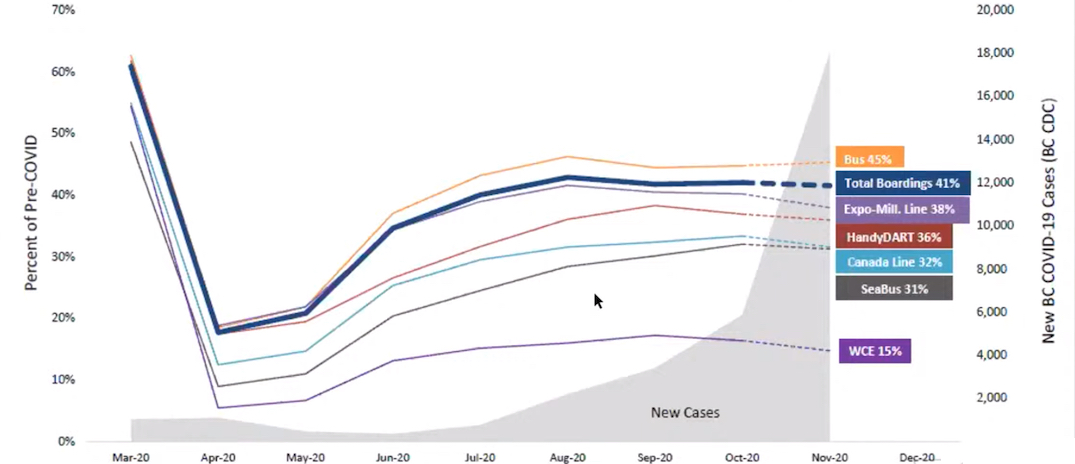TransLink's ridership rebound has flattened since the end of summer

Public transit ridership growth in Metro Vancouver has flattened in recent months, and with the latest spike in known COVID-19 cases and the implementation of new provincial health orders, ridership has fluctuated in recent weeks.
TransLink CEO Kevin Desmond laid out the latest statistics for the period ending in late November during last week’s Mayors’ Council meeting.
- See also:
Ridership reached a pandemic high of 44% of pre-COVID levels across all services combined, up from the pandemic low of about 17% in April.
About three weeks ago, with rising coronavirus cases and the new round of health orders enacted, ridership declined to 39%, before rebounding slightly to 41% the following week.
Across the services, ridership is now 45% of normal for buses, 38% for the Expo and Millennium lines, 32% for the Canada Line, 31% for the SeaBus, 15% for the West Coast Express, and 36% for HandyDART.

2020 TransLink ridership changes and the local COVID-19 case count. (TransLink)
“The changes in ridership have been very modest if not slight at this point of time, but I think we have to [keep in mind] that it is a pretty fluid situation. We just don’t know what’s going on with the progression of the pandemic,” said Desmond.
He says the general trend is largely mirrored in other major public transit systems around the world, especially in North America.
Desmond has previously stated that they do not want a significant and sudden resurgence of ridership, as TransLink has a safe operating plan that limits capacities of vehicles.
But ridership is currently trailing earlier projections, and the bigger implication is currently the impact on revenue through fares. In September, TransLink received $644 million in emergency operating funding from the provincial and federal governments to cover revenue losses to date and forecasted losses through the end of 2021. This was based on a “medium revenue scenario,” but they are now falling under this level “a little bit.”
With that said, the public transit authority is “trending far above what we call the low revenue scenario.”
The revenue forecast is also based on the assumption that widespread inoculations of the COVID-19 vaccine into the BC population will not happen until late 2021, but there is now reason to believe this could happen earlier, with the first inoculations set to begin this month.
“If it is earlier than expected, then the weak revenue performance right now could be offset into the second half of next year,” continued Desmond.
According to Statistics Canada’s release of data last week, public transit ridership across the country has steadily climbed each month since early spring, reaching 67 million in September, which is 59% lower than the same month last year.
September typically sees a surge in transit ridership, but not this year, for reasons that include online studies for most post-secondary students. A number of public transit authorities have also reduced their services to adapt with lower demand and their financial situations.
Operating revenues reported to Statistics Canada by several authorities reached $145.5 million over the course of September, amounting to a 61% decrease over the same month in 2019.
“It is almost certain that ridership will not return to pre-COVID-19 levels for some time. Like other businesses, transit must work to restore customer confidence by adopting innovative technologies such as, for example, real-time crowd counters or predictors, information on vehicle locations and contactless payment options as well as more demand-responsive services,” stated the national update.
During the same Mayors’ Council meeting, the region’s mayors re-elected New Westminster mayor Jonathan Cote and Langley Township mayor Jack Froese to their respective positions of chair and vice chair of the political governance body of TransLink.

